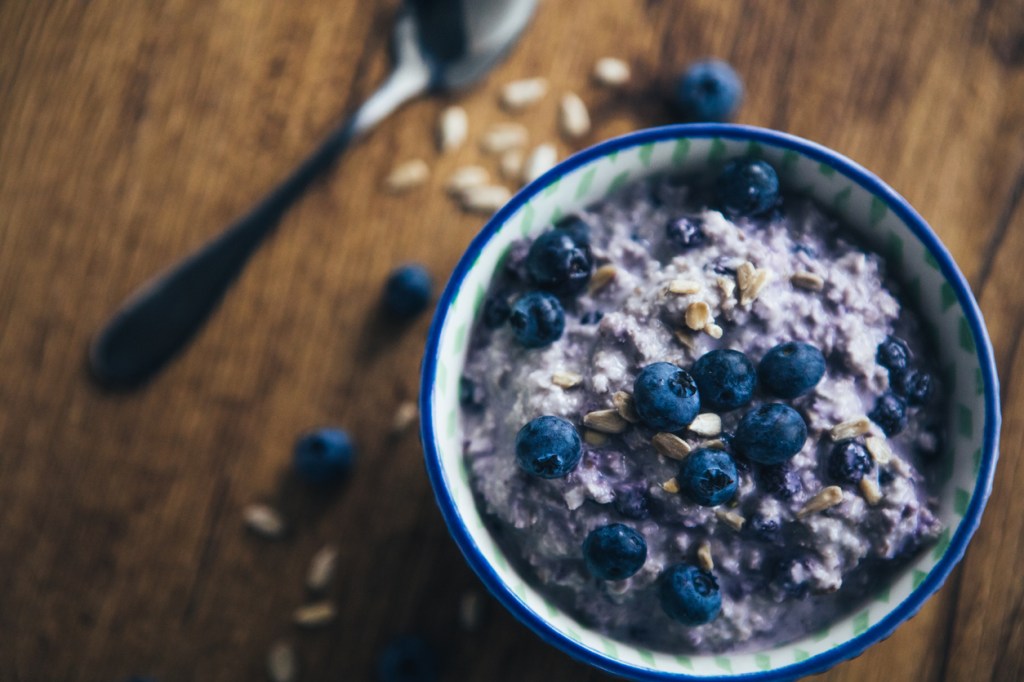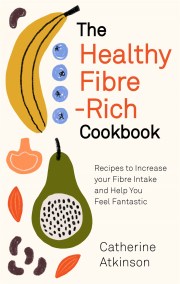Three delicious, fibre-rich recipes

The recipes below have been extracted from The Healthy Fibre-rich Cookbook: Recipes to Increase Your Fibre Intake and Help You Feel Fantastic by Catherine Atkinson.
Catherine Atkinson has a degree in Food and Nutrition BSc (Hons). She was deputy cookery editor on Woman’s Weekly magazine and later cookery editor of Home. Catherine is now a full-time writer and food consultant to various lifestyle and health magazines and has written more than sixty cookbooks.
Overnight Oats
A bowl of steaming hot porridge is a welcoming start on a wintry morning, but in the heat of summer you can still enjoy the benefits of oats with this Bircher-style breakfast which can be prepared the night before for a relaxed start to the day.
SERVES 6
125g porridge (rolled) oats
- 50g unsalted nuts such as almonds, or mixed nuts, roughly chopped
- 1 tbsp ground flax seeds (linseeds)
- ¼tsp ground cinnamon
- 1 large eating apple
- 4 tbsp apple or orange juice
- 300ml natural yogurt
- honey, maple syrup or date syrup for drizzling(optional)
- Put the oats, nuts, flax and cinnamon in a bowl and mix together. Leaving the peel on the apple, quarter, core and coarsely grate it into a small bowl, then immediately sprinkle over the apple or orange juice and stir to coat – this will help to stop it from going brown.
- Add the grated apple and yogurt to the dry ingredients and stir together. Leave the mixture in the bowl and cover with cling film, or divide it among six small glass pots with lids or suitable small containers. Chill in the fridge overnight; the mixture will thicken as the oats soak up the moisture. Serve with a drizzle of honey, if you like.
Alternative toppings (each serves 2)
Strawberry and blueberry Purée 75g hulled fresh or defrosted frozen strawberries and 2 tsp honey or maple syrup (optional) until smooth. Use to top the oats and scatter with fresh blueberries.
Mango and coconut Purée 100g fresh mango with 2 tbsp orange juice or pineapple juice. Use to top the oats and scatter with coconut flakes.
Banana and chocolate Mix 4 tbsp yogurt with 1 tbsp cocoa or cacao powder and 1 tbsp date syrup (see page 23). Use to top the oats and add sliced banana and a sprinkling of chopped 70 per cent (or more) dark chocolate.
Tip
Use a mild-tasting creamy bio yogurt for the best flavour and to reduce the desire to sweeten this breakfast. Once made, the overnight oats will keep in the fridge for up to 3 days.
Variations
If you like, reduce the amount of oats to 100g and add 1 tbsp chia seeds to the overnight oat mixture. You could also use some quinoa flakes (substitute an equal weight) instead of some of the oats for a protein boost.
Suitable for vegetarians. Vegans should use a non-dairy yogurt such as soya and serve with maple or date syrup.
Classic Kimchi
Along with fibre, fermented foods can help to increase the number of beneficial bacteria in your gut. Kimchi is an essential part of the Korean diet and provides a combination of salty, sweet, spicy and sour flavours. It’s delicious served as an accompaniment to grilled foods, cold meats and cheeses.
MAKES A 1 LITRE JAR
- 1 small head of Chinese leaves, finely shredded
- 1 red pepper, quartered, seeded and thinly sliced
- 1 large carrot, coarsely grated
- 150g radishes, thinly sliced
- 2 spring onions, thinly sliced
- 2.5cm piece of fresh ginger, peeled and grated
- 15g sea salt flakes
- 10ml fish sauce
- 10ml gochugaru (Korean chilli powder, see Tip)
- filtered or cooled boiled water, as needed
- Put all the prepared vegetables in a large clean bowl, add the ginger, then sprinkle over the salt. Gently massage the vegetables with your hands for 5 minutes. The vegetables will feel tough and squeaky at first, but will gradually soften and start to ooze juices. Leave to stand for 5 minutes; the salt will continue to work and extract juices from the vegetables.
- Sprinkle over the fish sauce and chilli powder, then mix and massage again for 2–3 minutes. You should now have a much-reduced volume of vegetables in their own briny juices.
- Pack the vegetables and brine into a sterilised, sealable 1 litre glass jar, packing down the vegetables so that they are completely submerged and leaving a 5cm fermenting space at the top of the jar. If there isn’t enough liquid, add a little filtered or cooled boiled water to cover.
- Put on the lid, close firmly, then loosen by a quarter turn. Leave the jar at room temperature out of direct sunlight for seven days. Each day allow any gases to escape by opening the lid, closing it firmly, then loosening it by a quarter turn.
- Taste after seven days, then every couple of days thereafter, until to your liking; it will get tangier and more fermented with time. Store in the fridge for up to 3 months; the cold will slow down the fermentation to almost nothing, although you should still open the jar now and then to allow the gases to escape.
Tips
If you can’t get gochugaru, use 1 tsp chilli powder (hot or mild, whichever you prefer) and 1 tsp smoked paprika.
When preserving by fermentation, it is essential that everything is clean. Mix the vegetables in a heatproof bowl that has been sterilised (as far as possible) by pouring in boiling water, leaving it for a few minutes, then carefully tipping it away. Chopping boards and other equipment should be very clean (a hot dishwasher is effective) as should be your hands, but don’t use anti-bacterial soap or washing-up liquid as these can destroy the beneficial bacteria that you are relying on to start the kimchi fermenting.
Kimchi is fairly salty, but the salt is essential for preventing the growth of harmful bacteria, so don’t be tempted to reduce it. You can squeeze out some of the salty brine when serving.
Suitable for vegetarians and vegans, if fish sauce is omitted.
Cauliflower and Chickpea Burgers
When you roast cauliflower it gives it a wonderful nutty flavour, completely different from when it is boiled. Here it is combined with caramelised roasted onions, chickpeas and wholemeal breadcrumbs to make tasty vegetarian burgers. Serve these in wholemeal buns with plenty of salad for a high-fibre meal. Sweet potato chips make a great accompaniment.
SERVES 4
- 1 small cauliflower, cut into florets
- 1 onion, sliced
- 2 tbsp rapeseed or sunflower oil
- 1 garlic clove, unpeeled and left whole
- 400g tin chickpeas, drained and rinsed, or 250g cooked chickpeas
- 1½tsp smoked paprika
- ½tsp dried mixed herbs
- 2 eggs, lightly beaten
- 50g wholemeal breadcrumbs
- flour, for dusting
- salt and freshly ground black pepper
- 4 wholemeal or brown burger buns
- lettuce, cucumber, sliced tomatoes and relish or Tzatziki (optional), to serve
- Put a non-stick baking tray in the oven and preheat to 200°C/fan oven 180°C/gas 6. Put the cauliflower in a bowl with the sliced onion. Drizzle over 1 tbsp of the oil and toss the vegetables together to coat.
- Tip the vegetables onto the hot baking tray. Add the whole garlic clove and roast for 15–20 minutes until the vegetables are tender and lightly browned. Turn once or twice during cooking so that they brown evenly. Remove from the oven and leave on the tray to cool for about 10 minutes.
- Transfer the vegetables to a food processor, squeeze out the roasted garlic from its papery skin, add the chickpeas and process for a minute until chopped. Scrape down the sides, add the paprika and herbs, and season with salt and pepper. Add the eggs and process for a further minute until the chickpea mixture is finely chopped. Scrape down the sides again, add the breadcrumbs and process until combined. The mixture should still have texture with visible pieces of cauliflower and not be a purée.
- With lightly floured hands, shape the mixture into four burgers. Put on a plate lined with baking paper, cover with cling film and chill until ready to cook.
- Heat the remaining 1 tbsp oil in a non-stick frying pan over a medium heat. Add the burgers, reduce the heat a little and cook for 5 minutes on each side until browned.
- Meanwhile, split the burger buns in half and fill with lettuce, cucumber and tomato slices. Add the cooked burgers and top each with the bun lid. Serve straight away with relish, if you like, such as a high-fibre sweetcorn relish or a spoonful or two of tzatziki.
Variation
Fresh herbs are also good in these instead of dried. Try adding 2 tbsp chopped fresh parsley or, for a different flavour, add 1 tsp ground cumin and ½tsp ground coriander to the mixture instead of paprika and 2 tbsp chopped fresh coriander.
Tip
The burgers can be frozen after cooking. Fry for just 3 minutes on each side until lightly browned, then allow to cool. Wrap individually and freeze for up to 3 months. Defrost in the fridge overnight and re-heat over a low heat in a non-stick frying pan.
Suitable for vegetarians. Vegans should use an egg substitute.
Fibre plays an essential part in a healthy diet, but most people don't get enough. Few of us know how much we should be consuming or how to increase our daily intake. This book answers these questions in detail and provides 70 delicious, fibre-rich recipes that will become favourites in your household.
The Healthy Fibre-rich Cookbook covers the most recent developments and nutritional knowledge about fibre. There's no need to buy a whole range of specialist ingredients; it's simply about adjusting your meals and eating habits. Here you will find a wide range of up-to-date recipes to inspire you throughout the day and show how easy it is to incorporate more fibre into your diet. This will include:
- Buttermilk banana pancakes
- Smoked paprika babaganoush
- Chicken empanadas
- Roasted vegetable and butterbean crumble
- Wholemeal spelt and honey biscuits
With this book you will get to know your gut, increase your fibre intake and feel better.








